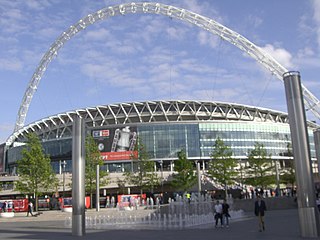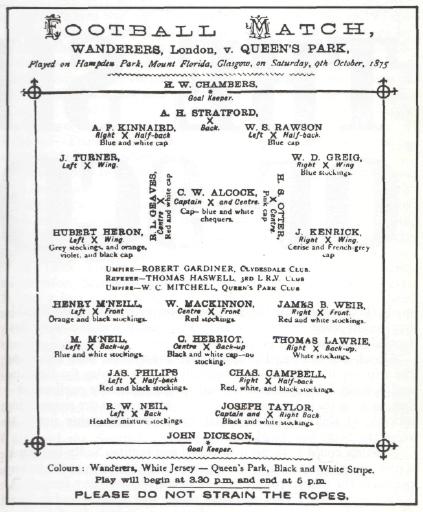
Stamp collecting is the collecting of postage stamps and related objects. It is related to philately, which is the study of stamps. It has been one of the world's most popular hobbies since the late nineteenth century with the rapid growth of the postal service, as a never-ending stream of new stamps was produced by countries that sought to advertise their distinctiveness through their stamps.

Christie's is a British auction house. It was founded in 1766 by James Christie. Its main premises are on King Street, St James's, in London and in the Rockefeller Center in New York City. The company is owned by Groupe Artémis, the holding company of François-Henri Pinault. Sales in 2015 totalled £4.8 billion. In 2017 the Salvator Mundi was sold for $450.3 million at Christie's, and which at that time was the highest price ever paid for a single painting at an auction.

The Football Association Community Shield is English football's annual match contested between the champions of the previous Premier League season and the holders of the FA Cup at Wembley Stadium. If the Premier League champions also won the FA Cup then the league runners-up provide the opposition. The fixture is recognised as a competitive super cup by the Football Association.

Maine Road was a football stadium in Moss Side, Manchester, England, that was home to Manchester City F.C. from 1923 to 2003. It hosted FA Cup semi-finals, Charity Shield matches, a League Cup final and England matches and, because of its high capacity, gained the nickname Wembley of the North. Maine Road holds the record for the second highest attendance for a club in their normal home stadium in English club football, set in 1934 at an FA Cup sixth round match between Manchester City and Stoke City.
In association football, a player who has appeared for a football club during a knockout cup but subsequently transfers to another club is ineligible to play for the new club in the remainder of that season's cup competition. Such a player is said to be cup-tied i.e. tied to their original club for the duration of the cup tournament. They become eligible for their new club in the following season.
Wanderers Football Club is an English amateur football club based in London. Founded as Forest Football Club in 1859, the club changed its name to Wanderers in 1864. Comprising mainly former pupils of the leading English public schools, Wanderers was among the dominant teams of the early years of organised football and won the Football Association Challenge Cup on five occasions, including defeating Royal Engineers in the first FA Cup final in 1872.

Blackburn Olympic Football Club was an English football club based in Blackburn, Lancashire in the late 19th century. Although the club was only in existence for just over a decade, it is significant in the history of football in England as the first club from the north of the country and the first from a working-class background to win the country's leading competition, the Football Association Challenge Cup. The cup had previously been won only by teams of wealthy amateurs from the Home counties, and Olympic's victory marked a turning point in the sport's transition from a pastime for upper-class gentlemen to a professional sport.

The 1876 FA Cup Final was a football match between Wanderers and Old Etonians on 11 March 1876 at Kennington Oval in London. It was the fifth final of the world's oldest football competition, the Football Association Challenge Cup. Wanderers had won the Cup on two previous occasions. The Etonians were playing in their second consecutive final, having lost in the 1875 final. Both teams had conceded only one goal in the four rounds prior to the final. In the semi-finals Wanderers defeated Swifts and the Etonians beat the 1874 FA Cup winners Oxford University.
The 1882 FA Cup Final was contested by Old Etonians and Blackburn Rovers at the Kennington Oval. Old Etonians won 1–0, the only goal scored, according to most reports, by William Anderson, although another, questionably, gives Reginald Macaulay. It was the last final to be won by one of the Southern "gentleman amateur" teams who had dominated the first decade of the competition.

The T206 Honus Wagner baseball card depicts the Pittsburgh Pirates' Honus Wagner, a dead-ball era baseball player who is widely considered to be one of the best players of all time. The card was designed and issued by the American Tobacco Company (ATC) from 1909 to 1911 as part of its T206 series. Wagner refused to allow production of his baseball card to continue, either because he did not want children to buy cigarette packs to get his card, or because he wanted more compensation from the ATC. The ATC ended production of the Wagner card and a total of only 50 to 200 cards were ever distributed to the public, as compared to the "tens or hundreds of thousands" of T206 cards, over three years in sixteen brands of cigarettes, for any other player. In 1933, the card was first listed at a price value of US$50 in Jefferson Burdick's The American Card Catalog, making it the most expensive baseball card in the world at the time.

The Guennol Lioness[ˈɡwɛnɔl] is a 5,000-year-old Mesopotamian statue allegedly found near Baghdad, Iraq. Depicting a muscular anthropomorphic leonine-human, it sold for $57.2 million at Sotheby's auction house on December 5, 2007. The sculpture had been acquired by a private collector, Alastair Bradley Martin, in 1948 from the collection of Joseph Brummer, and had been on display at Brooklyn Museum of Art in New York City from that time to its sale in 2007. It is called "Guennol" after the Welsh name for "Martin", the name of the collector. In 1950 Edith Porada described it as a lioness "because of the feminine curves of her lower body and the absence of male organs" while conceding the possibility "that the figure represented a sexless creature".
Victor Lewis "Vic" Halom is a former footballer
The history of the FA Cup in association football dates back to 1871–72. Aside from suspensions during the First and Second World Wars, the competition has been played every year since.
Pauline Karpidas is an English contemporary art collector, private art space benefactor, socialite, and patron of the arts.
The Graff Pink, a rare 24.78 carat pink diamond, once owned by American celebrity jeweller Harry Winston, has been described as "one of the greatest diamonds ever discovered". The diamond, mounted in a ring, was sold by Sotheby's auctioneers in Geneva, Switzerland on 16 November 2010. Before its sale, the stone was expected to enter the list of the top ten most expensive diamonds in the world; on selling for US $46 million it became the most expensive single jewel ever sold at auction at that time.

Les Femmes d'Alger is a series of 15 paintings and numerous drawings by the Spanish artist Pablo Picasso. The series, created in 1954–1955, was inspired by Eugène Delacroix's 1834 painting The Women of Algiers in their Apartment. The series is one of several painted by Picasso in tribute to artists that he admired.

The Doria Atlas is a 16th-century atlas commissioned by and named for the Genoese military leader Andrea Doria. Likely compiled around 1570, it is a composite atlas featuring 186 printed and manuscript maps from two distinct atlases of the Lafreri school. It also contains rare Italian maps dating to the 1620s, in addition to a series of manuscript maps, written by little-known publishers during the 1620s and 1630s and detailing the commercial, political and military interests of the Doria family. As of the 21st century it is one of the world's most expensive books.














